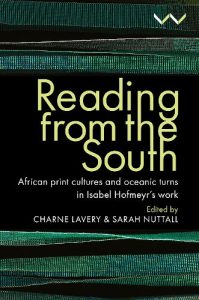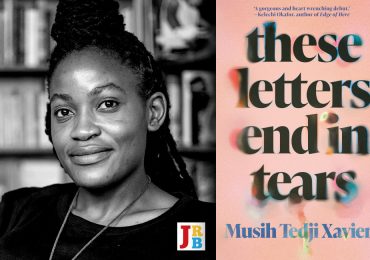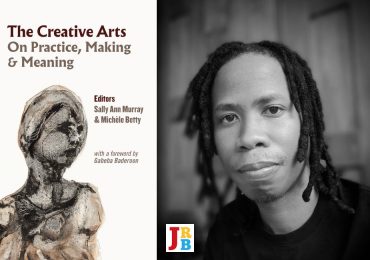The JRB presents an excerpt from Reading From the South: African Print Cultures and Oceanic Turns in Isabel Hofmeyr’s Work.

Reading From the South: African Print Cultures and Oceanic Turns in Isabel Hofmeyr’s Work
Charne Lavery, Sarah Nuttall (eds)
Wits University Press, 2023
Hemispheric Limits: Rethinking the Uses of Diaspora from South Africa
Christopher EW Ouma
Isabel Hofmeyr’s ground-clearing essay, ‘The Black Atlantic Meets the Indian Ocean: Forging New Paradigms of Transnationalism for the Global South—Literary and Cultural Perspectives’ (2007), poses an important question and (subsequently) a theoretical challenge for transnational and globalisation studies that try to conceptualise the movement of people, ideas and cultures around the world. Hofmeyr asks: ‘What of non-Western sources of globalisation or processes of transnationalism that happen without reference to Europe?’ (2007, 3). This question is at the heart of the analytical logic of Hofmeyr’s much-cited article. In very interesting ways, the question is imploring us—as Dipesh Chakrabarty (2000) does—to ‘provincialise Europe’. Ngũgĩ wa Thiong’o (1992) has used another expression elsewhere: to ‘move the centre’. Hofmeyr deploys the taxonomy of ‘South’ to locate what she argues are ‘universalisms’ that have big historical footprints in Africa’s encounter with the rest of the world through the Indian Ocean. The Indian Ocean, she argues, pivots ‘transnationalism within the South itself ’ (2007, 3) and, from the perspective of South Africa, therefore provides a very specific enunciation of transnational studies that particularly challenges the dominance of Paul Gilroy’s (1993) formulation of ‘the Black Atlantic’ in that field.
My essay seeks to place Isabel Hofmeyr’s thinking alongside that of Brent Hayes Edwards (2001, 2003) to make an argument for the ways in which both scholars not only broaden the framework within which the word ‘diaspora’ operates as an analytic, but also complicate its cartographic logic in ways that speak to how we might, for example, read from a place such as Cape Town—a place at the very tip of the ‘two oceans’. Hofmeyr herself ‘suggests that we look quite literally at our location in Southern Africa—between two oceans—and see what analytical purchase that may provide … what can we derive from thinking about three intersecting frameworks: the black Atlantic, the Indian Ocean and Africa itself?’ (2007, 4).
The point Hofmeyr makes here is critical, not only in expanding away from a singular oceanic frame of reference, but also in suggesting ways of multi-directional reading from the geography of the Cape and, more broadly, southern Africa. She offers us a strategy of reading, as it were, from the Cape. Hofmeyr, Sarah Nuttall and Charne Lavery (2022) expand this strategy in the special issue of Interventions titled ‘Reading for Water’, in which broader debates on the Anthropocene are informed by ‘hydropoetics’—ways in which water formulates a narrative aesthetic in various kinds of cultural production—and are brought together with ‘oceanic studies’. In other words, reading for water makes visible the critical purchase of a multi-directional logic of oceanic studies such as the one Hofmeyr proposes in ‘The Black Atlantic Meets the Indian Ocean’. Hofmeyr, Nuttall and Lavery extend the tropology of a multi-directional reading by proposing how ‘reading for water moves laterally, vertically and contrapuntally between different water-worlds and hydro-imaginaries’ (2022, 304). These strategies of reading are inherent in the locations from which we embark on them, such as the place of ‘two oceans’. South Africa, and particularly Cape Town, provide this strategic position and in crucial ways supply what Edwards calls a location for the ‘hemispheric limits’ (2001, 62) from within which the concept of diaspora is inhabited by the ‘hydro-imaginaries’ that Hofmeyr and others are reading for.
In his own field-defining essay, ‘The Uses of Diaspora’, Edwards also argues for a ground-clearing ‘intellectual history of the term’ (2001, 64), locating it at a moment in which it is ‘taken up … in black scholarly discourse to do a particular kind of epistemological work’ (46). This assumption chimes with Hofmeyr’s concern about the geographical framing of ‘diaspora’ as the ‘Black Atlantic’, in which a specific cartographical logic applies and overdetermines the concept in relation to Africa. Edwards’s article gives us a wider lens through which to appreciate Hofmeyr’s specific intervention, through its genealogical, even archaeological, approach to the concept of diaspora and the history of its political economy. By tracing the term diaspora in what he calls ‘black scholarly discourse’, Edwards makes connections between ‘Pan-Africanism’ as a form of identity and imagination, and the emergence of the category ‘African diaspora’ up to the moment when it acquires what he calls ‘racial essentialism or American Vanguardism’ (57). This essentialism and vanguardism are linked to the ethical import of Hofmeyr’s own intervention, which offers to locate South Africa and the Cape precisely as operating beyond them. In his broader work, The Practice of Diaspora (2003), Edwards’s conceptual genealogy of the formulation ‘diaspora’ creates a broader canvas on which to trace the ways in which the political work of ‘Pan-African’ imagination during the interwar period is deployed into a cultural currency that comes to embody the term ‘diaspora’ in black studies, and therefore begins to acquire not only a North Atlantic provenance but also an American vanguardism.
In doing this work of intellectual history, Edwards lays out a conceptual map from which we can plot the taxonomic spectrum—‘Pan-African’, ‘African Diaspora’, ‘North Atlantic’, ‘South Atlantic’ and so on. These formulations provide theoretical points of enunciation and ways to differentiate various cartographical provenances. To think of the global South as Hofmeyr is doing in her essay is to reconfigure these cartographical provenances. But Edwards’s argument prefigures Hofmeyr’s own concerns by ‘provincialising’ Paul Gilroy’s (1993) formulation ‘the Black Atlantic’—locating it at a specific moment overdetermined by the cultural turn within transnational studies and, more importantly, warning of the risks of North Atlantic vanguardism. Beyond the critical work that Ntongela Masilela (1996) and Laura Chrisman (2005) have done in unpacking the concept’s deficiencies in relation to Africa, Edwards brings us the important dimension of Gilroy’s context: black British consciousness and its various influences, most of which Gilroy’s concept glosses over and flattens. As Edwards puts it:
The issue, of course, is the stakes of the ‘Black Atlantic’ as a term that (particularly in the adoption of Gilroy’s work in the U.S. academy) often usurps the space that might otherwise be reserved for diaspora. The success of the Black Atlantic has cleared space for a wide range of intellectual work in the academy; still, this development makes it all the more crucial to ask about the risks of ‘Black Atlantic’ as a term of analysis that is not necessarily consonant with the sense of diaspora as intervention that I have described. (2001, 61)
Edwards is doing important ground-clearing work here—wading through what has become a conceptual fog. By making distinctions between the concept of diaspora and that of the ‘Black Atlantic’, he is cautioning against the deployment of the latter term as shorthand for the former—which indeed happened frequently in the aftermath of Gilroy’s work. Moreover, like Hofmeyr, Edwards is hinting at what he calls the ‘hemispheric limits’ that attend to the formulation ‘Black Atlantic’—especially the way it is meant to produce a very confined and specifically monodirectional idea of diaspora studies—under the assumption that Atlantic histories of the type that Gilroy’s formulation seeks to account for and other oceanic studies are mutually exclusive. Edwards says:
This continuing discourse of diaspora begs the question of the introduction of the notion of the ‘Black Atlantic’, which would seem to impose an assumption of geographical specificity (what we might term a hemispheric limit) and a ‘racial’ context on a field that might be much more broad and more various. (2001, 62)
Hofmeyr’s essay ‘The Black Atlantic Meets the Indian Ocean’ begins with the supposition that the field is broad and various and could extend in generative ways, beyond the Atlantic, based on specific cartographies of enunciation. Hofmeyr foregrounds the way in which the Atlantic seaboard has calcified the intellectual discourse on capitalist modernity in relation to Africa, forging a dominant paradigm of the analysis through various categories that emerge from its exchange system: ‘slaves’, ‘slavery’, ‘settler’, ‘native’, ‘migrant’ and—the ‘concept-metaphor’ at stake—‘diaspora’. In her essay, she performs the intellectual labour that Edwards (2001) is asking for: she provides a genealogy of scholarly discourse on the Indian Ocean, outlining the various directions in which movement happened in this particular oceanic space while foregrounding the nuanced political economy that underwrote enslaved and indentured, free, migrant and settler identities. Hofmeyr’s analysis throws up the kinds of modernity that not only intersect, but also remain surplus—she uses the word ‘alternative’—to the Atlantic one. As a result, one is able to appreciate Hofmeyr’s argument about the peculiarity of South Africa and the Cape in relation to the multiple modernities she touches on. The location entailed calls for a reconfiguration of received categories of Atlantic modernity, such as that of diaspora, and of how they shape South African literary and cultural imagination. In tracing the much longer history of Indian Ocean contact with eastern and southern Africa, Hofmeyr maps a broader historical terrain to propose an idea of the South that seriously heeds the interlacing and intersectional histories literally converging at the southern tip of the continent and the world. In this location, Hofmeyr broadly proposes ways to read reconfigured space by reading water. In the case of the Southern water where the Cape is located, this approach provides innovative perspectives.
To read from the Cape is therefore to consider, for instance, a wider and deeper historical perspective in which enslavement and indentured labour come together to result in race and sexuality forming categories of belonging at the crucible of Atlantic and Indian Ocean encounters, as Gabeba Baderoon (2014) argues. Baderoon develops an interventive art of reading the Cape by foregrounding how Muslims and their presence in South Africa expand the historical boundaries from within which to theorise South African identity—a longer durée—in which we can plot a temporal palimpsest that begins with Indian Ocean enslavement and becomes more deeply layered with the inauguration of apartheid. In other words, Muslims and their specific location in the Cape provide a tropology of critical historical memory across these periods. Such an injunction about time, history and the imagination of South African identity seeks not only to displace the competitive memory of apartheid and its Atlantic-dominated frameworks of understanding, but also to reconfigure South Africa’s place in Southern history by reading from the Cape.
Reading from the Cape prolongs the historical view of South Africa as a Southern location, demonstrating a temporal palimpsest in which enslavement, colonialism and apartheid build onto each other. Yet, in light of Hofmeyr’s essay, the temporal intersections bringing together the two oceans often complicate the mono-directionality of a palimpsestic reading. Baderoon employs both a palimpsestic and an intersectional reading of time and the formation of identity by centring Muslims. Such a reading takes into account the representational economy built over centuries, in which Muslims, Islam and Islam’s cultural footprints form the cartographical palimpsest in which tourist consumption happens, but at the same time the counterpoint of indentured labour and enslavement lies at the very foundations of this enterprise. And so, to ask the question Pumla Gqola (2010) asks—‘What is slavery to me?’—is to confront the limits of competitive imperial memory drawn only from Atlantic frameworks of southern African history. It is to give conceptual substance to the category ‘South’ and to its Cape-inflected dimensions—‘two oceans’, ‘South Atlantic’ and ‘Southern Ocean’, among other formulations.
For example, in looking at Yewande Omotoso’s novel The Woman Next Door (2016), we are able to note ways in which suburban Cape Town is a geography acted upon and curated by imperial projects that began during the period of enslavement and calcified with apartheid. Omotoso creates a narrative in which the upper-middle-class suburb of Constantia is a chronotope, with space the basis of a specific sense of belonging that is being curated by imperial time. Constantia in the novel is an ‘architext’ for the competing and intersecting memories of enslavement, colonialism and apartheid. Here the afterlives of enslavement are etched onto the landscape, in this case centuries-old trees that line a driveway, marking slave burial grounds and indicating the contested histories of land dispossession that mark the ‘post-apartheid’ as a period of competitive memory. Omotoso stages an encounter between two octogenarians, one black and from the Caribbean and the other a white South African. Their relationship is mediated by the intersections of class and race, but with the specific racial histories of the South Atlantic intervening as contextual inflection. In this way, the South Atlantic becomes a platform that convenes an encounter between postcolonial and postapartheid frameworks of belonging. Omotoso’s narratives, by being positioned in the Cape, harness these triangulated anglophone African, Caribbean and South African identities, helping us to reconfigure those ‘hemispheric limits’ of the Atlantic and therefore our ‘uses’ of diaspora in the global South.
Reflecting on the Omotoso example helps us partially draw in Hofmeyr’s injunction regarding South African literature’s positioning within Southern logics, in the way it projects from its location as part of Southern universalisms. Baderoon takes the relationship between David Lurie and Soraya in JM Coetzee’s Disgrace (1999) as an example of the intersections between race, gender and sexuality at the crucible of historical encounters between the two oceans, which over time developed a cultural grammar that brings together surplus capital, leisure, and the exoticisation of Muslim bodies and cultures. Baderoon draws on various forms of cultural production, prominent among them the work of the artist Berni Searle, which presents racialised and sexualised bodies as symptomatic sites of cultural consumption, but speaks broadly to structural histories of enslavement and colonialism and how they have marked the landscape of the Cape.
The irony of the formulation ‘Mother City’ in referring to Cape Town lies not only in the problematic gendered ‘pedestal’ but also in the way that Dutch colonial and settler history is often seen as the originary moment of southern African urbanism and civilisation. While this formulation belies the structural violence occasioned at the intersection of race and gender (the originary ‘sin’), it also articulates itself as the dominant form of imperialism over the past couple of centuries. Indeed, the competing imperialisms that occasioned the ‘trek’ and led to the South African War, the formation of the Union and the emergence of apartheid provide the context for South Africa’s sub-imperialism within the global South. They therefore necessitate the kind of reading Hofmeyr is asking us to deploy, expanding our perspective away from the Atlantic seaboard so as to be able to map the historical currents from the Indian Ocean that nuance our taken-for-granted categories, including those of ‘settler’, ‘native’, ‘slave’ and ‘indentured labourer’.
Hofmeyr’s essay remains a crucial scholarly intervention, creating a conceptual pathway for reading from the location of South Africa towards the rest of the world. To think about the intellectual category ‘South’ is to think, like Hofmeyr, at the intersection of oceans, to think of the Cape and South Africa as a pivotal geography but with multiple counterpoints. This type of reckoning means rethinking received categories such as ‘Black Atlantic’ and ‘diaspora’, categories that need to be relocated to inhabit the context of two oceans. It is apposite, therefore, that from this important essay, Hofmeyr’s major contributions to Indian Ocean studies and oceanic humanities in particular have morphed into another important conceptual metaphor, encapsulated in the formulation that is the subject of her co-edited special issue ‘Reading for Water’ and her recent monograph, Dockside Reading: Hydrocolonialism and the Custom House (2021). Her work not only offers rich genealogical frameworks and creates conditions for building new concepts, but also provides interventionist ways of reading—a key analytic and intellectual pastime for Isabel Hofmeyr.
~~~
- Christopher EW Ouma is an Associate Professor in the Department of English at the University of Cape Town. Ouma is the author of Childhood in Contemporary Diasporic African Literature: Memories and Futures Past.
~~~
REFERENCES
Baderoon, Gabeba. 2014. Regarding Muslims: From Slavery to Post-apartheid. Johannesburg: Wits University Press.
Chakrabarty, Dipesh. 2000. Provincializing Europe: Postcolonial Thought and Historical Difference. Princeton: Princeton University Press.
Chrisman, Laura. 2005. ‘Beyond Black Atlantic and Postcolonial Studies: The South African Differences of Sol Plaatje and Peter Abrahams’. In Postcolonial Studies and Beyond, edited by Ania Loomba, Suvir Kaul, Matti Bunzl, Antoinette Burton and Jed Esty, 252–271. New Delhi: Permanent Black. Coetzee, J.M. 1999. Disgrace. London: Secker & Warburg.
Edwards, Brent Hayes. 2001. ‘The Uses of Diaspora’. Social Text 66, no. 1 (Spring): 45–73.
——— . 2003. The Practice of Diaspora: Literature, Translation and the Rise of Black Internationalism. Cambridge, MA: Harvard University Press.
Gilroy, Paul. 1993. The Black Atlantic: Modernity and Double Consciousness. Cambridge, MA: Harvard University Press.
Gqola, Pumla. 2010. What is Slavery to Me? Postcolonial/Slave Memory in Post-apartheid South Africa. Johannesburg: Wits University Press.
Hofmeyr, Isabel. 2007. ‘The Black Atlantic Meets the Indian Ocean: Forging New Paradigms of Transnationalism for the Global South—Literary and Cultural Perspectives’. Social Dynamics 33 (2): 3–32.
——— . 2021. Dockside Reading: Hydrocolonialism and the Custom House. Durham: Duke University Pres; Johannesburg: Wits University Press.
Hofmeyr, Isabel, Sarah Nuttall and Charne Lavery, eds. 2022. ‘Reading for Water’. Special issue, Interventions 24 (3): 303–322.
Masilela, Ntongela. 1996. ‘The “Black Atlantic” and African Modernity in South Africa’. Research in African Literatures 27 (4): 88–96.
Ngũgĩ wa Thiong’o. 1992. Moving the Centre: The Struggle for Cultural Freedoms. London: James Currey Publishers.
Omotoso, Yewande. 2016. The Woman Next Door. London: Chatto and Windus.
~~~
Publisher information
This set of essays analyses the work of Isabel Hofmeyr, globally recognised as one of South Africa’s foremost literary and Indian Ocean scholars. The essays elucidate Hofmeyr’s path-breaking studies of transnational histories of the book, African print cultures, and cultural circulations in the Indian Ocean world.
This book draws together reflective and analytical essays by renowned intellectuals from around the world who critically engage with the work of one of the global South’s leading scholars of African print cultures and the oceanic humanities. Isabel Hofmeyr’s scholarship spans more than four decades, and its sustained and long-term influence on her discipline and beyond is formidable.
While much of the history of print cultures has been written primarily from the North, Isabel Hofmeyr is one of the leading thinkers producing new knowledge in this area from Africa, the Indian Ocean world and the global South. Her major contribution encompasses the history of the book as well as shorter textual forms and abridged iterations of canonical works such as John Bunyan’s The Pilgrim’s Progress. She has done pioneering research on the ways in which such printed matter moves across the globe, focusing on intra-African trajectories and circulations as well as movements across land and sea, port and shore.
The essays gathered here are written in a blend of intellectual and personal modes, and mostly by scholars of Indian and African descent. Via their engagement with Hofmeyr’s path-breaking work, the essays in turn elaborate and contribute to studies of print culture as well as critical oceanic studies, consolidating their findings from the point of view of global South historical contexts and textual practices.





